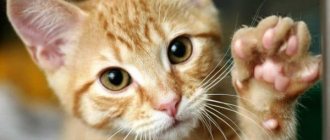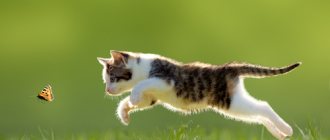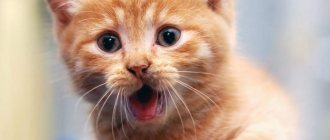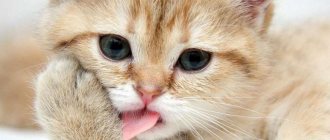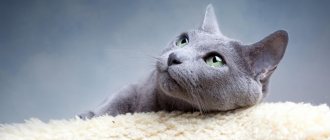Mating, or mating of males and females, is an important process necessary for breeding a breed. The production of healthy offspring is ensured by compliance with a number of rules governing the preparation of animals and the preparation of documents. If the pet is not yet untied, it will most likely need the help of its owner. Knowing the basic nuances will help resolve any emergency situation during mating.
Cats are much more careful in lapping than dogs.
© www.wodumedia.com
Instead of simply scooping up water with its tongue, as a dog does, a cat, when lapping milk or other liquid, touches the surface with the rough tip of its tongue and draws it into the mouth along with the resulting column of liquid, closing its jaws to prevent moisture from escaping.
A cat can lap at a rate of four times per second, receiving about 0.1 ml of liquid each time - so it can drink about 5 tablespoons (24 ml) per minute.
Mating and conception: how it happens
The animals get to know each other, if the cat does not show aggression, the male begins to emit an inviting howl, the female meows in response, and takes a specific pose.
The partner jumps on the cat, grabs it by the withers with his teeth, holds it tightly with his front paws, inserts the genitals into the vagina, freezes, begins to make forward movements until the seminal fluid is released, mating time is 1-2 minutes. Repetition of sexual intercourse occurs after 15-25 minutes; cats are able to mate 6-9 times per day.
Be sure to read:
At what age is it better to adopt a kitten: when is it possible, why can’t it be taken early, what are the dangers
The period of conception begins the next day after sexual intercourse.
A little about cat sex
© news.priorsmart.com
Cats, like males of many other animals, have small spines on their penises. Scientists still cannot say unambiguously what function these outgrowths, about 1 mm long, perform, but most agree that the spines do not allow the penis to slip out of the female’s vagina during ejaculation and, in addition, serve as an additional source of sexual stimulation for both the cat and for the cat.
Male hormones are responsible for the formation of spines, so if a cat is sterilized at an early age, the amount of hormones will greatly decrease and the spines will either not grow at all, or their number will not be very large.
Help from the owners
Understanding when your help is needed is quite simple. Most often, breeders are faced with 4 problems that require their intervention.
When a cat rolls over on its side
If the cat has fallen over on its side, do not rush to intervene. Experienced males solve this problem on their own even in such an uncomfortable position. If mounting still does not occur, carefully approach the animals and support the female. Remember that human intervention makes cats nervous and is only necessary as a last resort. While supporting, do not touch the animals' genitals.
If your cat behaves aggressively
Prolonged aggression on the part of a pet is a reason for refusal. Otherwise, mating will end in a fight and injuries for both partners. It’s safer to find a new “groom.”
If the breeding value of the found partner is high, breeders resort to a probe. This device is inserted into the female's vagina. She stops resisting and allows the male to approach her. It is better to entrust such manipulation to a veterinarian.
If the sizes of partners do not match
Disproportion between partners is rare, since animals of the same breed usually have similar dimensions. A male that is too large can injure the female, so it is recommended to avoid such mating. The reverse situation is safer. During mounting, the cat will rest against his partner's back, so you will have to help him with direction.
With a sudden cessation of estrus
A sudden change of environment is stressful for the animal. Fright may cause the female to stop estrus. This is not something to be afraid of, as it returns immediately after the condition returns to normal. Leave her at your partner's house for a couple of days to let her get used to him and the new place.
Modern cats are often obese
© www.deviantart.com
In recent years, the problem of excess weight increasingly concerns not only people, but also their furry pets. According to research from the Association for Pet Obesity Prevention, about 54% of dogs and cats are overweight to some degree. This means that there are approximately 324 million “fat cats” among domestic cats around the world.
Most often, problems with excess weight in domestic cats begin due to a lack of physical activity and loving owners who, indulging their pets, give them too much food. A typical adult cat needs between 180 and 220 calories per day, and the average cup of cat food, for example, contains almost 400 calories.
What should the owner do?
If physiological reasons are not suitable, and the pet’s condition does not return to normal, trust the veterinarian. Self-medication in such a situation can only aggravate the existing problem.
Diagnostics
The symptoms of many diseases are the same, so before starting treatment it is necessary to establish the exact cause of the ailment. In addition to examination and history taking, the following results will be required to make a diagnosis:
- general and biochemical blood test;
- Ultrasound of the abdominal cavity;
- vaginoscopy;
- x-ray;
- a smear or scraping from the vagina;
- bacterial sowing;
- biopsies.
The number of studies will depend on the condition of the animal. The list presented may be expanded or shortened.
Treatment
Depending on the diagnosis, drug or surgical treatment is used. Mild forms of infection, vaginitis and pyometra are treated with antibiotics and douching.
A more radical method of therapy is castration, that is, the complete removal of all reproductive organs. The operation is mandatory if there is a threat to life (malignant tumor, closed pyometra). Also, surgical intervention is necessary to correct the consequences of poor-quality sterilization and removal of placenta fragments.
Cats are no smarter than dogs...
© www.galleryhip.com
The mental abilities of cats are usually no higher than those of dogs. According to data published in 2010 in the journal Proceedings of the National Academy of Sciences, over the past 60 million years, the brains of dogs have noticeably increased in size, but nothing similar has been observed in cats.
In 2009, an experiment was conducted, the purpose of which was to put an end to the dispute between “cat people” and “dog people”, who is smarter - dogs or cats? Of course, the comparison of mental abilities cannot be called absolutely correct - these are two different species and each is good at something different, and scientists considered one of the most important arguments in the dispute to be the benefits that cats and dogs can bring to humans.
Basic breeder rules
Mating of purebred cats and cats is a labor-intensive process that requires an understanding of selection and jurisprudence. Inexperienced breeders make their first mistake when searching for a partner.
How to choose a “groom” or “bride”
In a future partner, not only health is important, but also color and blood type. When incompatible blood types are mixed, kittens may be born dead or defective. In the second case, the animals will not have breeding value and will receive no higher class than pet. This will reduce the cost and eliminate them from breeding.
For the safety of your pet and future offspring, it is recommended to contact felinological clubs. Here you will find several suitable partners. This will eliminate downtime until the next heat due to an unsuccessful encounter. If the pet is not delighted with the “bride” or “groom”, you can immediately arrange a meeting with the new applicant.
Mistakes are often made when mating Scots. Within the breed there is a division into “straights” (straight ears) and “folds” (fold ears). Crosses within one group are unacceptable, as they are fraught with defects in future offspring. All these nuances can be learned during a consultation at a specialized club.
Paperwork
Before mating a cat and a cat, their owners draw up an agreement. The document specifies the basic rules, obligations and rights of the parties, controversial issues, type of payment and pregnancy support. To confirm the breed and health of partners, their pedigrees and veterinary passports are checked.
Most often, the owner of the male accepts payment in the amount of the cost of one of the kittens. The first part of the money is provided before or immediately after mating, and the second - after childbirth.
When to take your pet home
After fertilization, the female remains in the male’s territory for up to 5 days. The exact number of days is specified in the contract. During this time, several sexual acts occur, increasing the likelihood of conception.
The host owner takes care of his pet's partner until the specified time. After that, he returns her home. It is the responsibility of the female owner to notify her of successful fertilization.
...but cats are still intelligent in their own way
© www.mashable.com
Let dogs interact much more actively with people, do not assume that cats can only eat, sleep and force you to regularly change the litter in the cat litter. Domestic cats, like their relatives living in the wild, have all the necessary skills to, for example, outsmart prey or deceive an enemy.
In 2010, Wildlife Conservation Society staff managed to film the hunt of the long-tailed margay cat, which lives in the Amazon forests. Wanting to get one of the small tamarin monkeys for dinner, the cat quite accurately imitated the cries of these animals, and when some of the tamarins got closer, she set up an ambush. Only the warning cry of the leader saved one of the monkeys from reprisal, but it can be assumed that in the end the patient margay finally achieved her goal, or went off to look for other, less capricious prey.
Digestive system
The cat's insides form the digestive system, which is responsible for taking in food, processing and eliminating undigested residues. A cat’s body processes food within a day.
Participating in this process are:
- oral cavity;
- pharynx;
- esophagus;
- stomach;
- small and large intestines;
- kidneys and liver.
A cat's stomach is more acidic than a human's, so it can process rough food. The structure of a cat's intestines does not allow it to digest carbohydrates well. This must be taken into account when planning your diet.
Digestive organs
Digestion begins as soon as food enters the oral cavity. Saliva softens food and promotes quick chewing. Then the food passes through the pharynx and esophagus into the stomach. There, the active breakdown of foods into liquid, carbohydrates, proteins and fats begins. The contents then pass into the duodenum and small intestine. Unprocessed residues form feces and pass through the rectum.
Interesting! The pet's stomach is in constant activity. This is why animals often eat, but little by little.
The cat's digestive system consists of:
- esophagus;
- stomach;
- small intestine;
- duodenum;
- jejunum;
- liver;
- large intestine.
The esophagus has a hose-like shape of a relatively small size, and connects the animal’s mouth and its stomach. The esophagus originates from the inner base of the mouth, extends through the neck and chest, passes close to the heart, extends through the muscles of the diaphragm, and connects to the stomach.
The cat's stomach is single-chambered, and is distinguished by the location of the mucous membrane on its inner walls. The cat's stomach is adapted to accommodate a large amount of food, but it is almost never completely filled, since cats are not prone to gluttony (the vast majority).
Also, the inner surface of the stomach is dotted with folds, which have an additional mechanical effect on the process of breaking down food. Food processed by gastric juice enters the duodenum through the pyloric sphincter. Most often, eaten food remains in the stomach for about 12 hours.
The small intestine is a tubular organ that connects the stomach and large intestine. Often the length of a cat's small intestine is about 1.5-2 meters, and includes the duodenum, jejunum, and ileum.
The duodenum is small in size and serves to mix food with liver and pancreatic enzymes, which is extremely important for digestion.
The jejunum is the longest part of the small intestine, and its internal walls are dotted with thin hairs, which, when in contact with food that comes into contact with them, penetrate into it and suck out all the useful substances. It is here that the final extraction of all useful substances from food occurs, after which it enters the ileum, and then the large intestine, where it turns into feces.
The large intestine in cats works like in all mammals: it serves to temporarily store feces, as well as remove it from the anus. Also here, the walls of the large intestine absorb moisture from the feces stored in it, in order, if necessary, to maintain the necessary water balance in the body.
The liver is the largest gland in the cat's body, and breaks down nutrients obtained from the stomach and intestines into elements necessary for the body. It is important to note that in order to fully produce the required complex of amino acids, the cat must receive 90% protein in its diet, otherwise the animal will die, because the liver will not be able to provide the body with the necessary substances from plant foods.
General diagram of the structure of the internal organs of cats
Cats live for 10 minutes
© www.followthewabbit.com
Cats are able to remember any obstacle in their environment for only about 10 minutes - this is the conclusion made by experts based on the results of a study conducted in 2007.
During the experiment, scientists created artificial barriers that furry subjects had to overcome. It turned out that if you stop a cat after it has stepped over an obstacle with its front paws and do not allow it to continue on its way for 10 minutes, the animal forgets that it is necessary to step over the barrier with its hind paws too, although if you stop it for a short time, the barrier will be “taken” practically straightaway.
The visual memory of cats is much shorter than the muscular memory - if you distract the pet from an obstacle before it begins to overcome it, the cat forgets about the unsolved problem.
Respiratory system
The anatomy of the respiratory system of cats is similar to other carnivorous mammals and consists of the nose, nasopharynx, larynx, trachea, bronchi and, of course, lungs.
The respiratory system is designed to carry out gas exchange in any environmental conditions (if there is oxygen), as well as saturate the body with this oxygen through its processing by the lungs. The structure, functions and principle of operation of the lungs are similar to other animals, and have no distinctive characteristics. The task of the respiratory organs is to ensure gas exchange and deliver oxygen to the tissues. The process of releasing excess moisture also goes through them. The respiratory system participates in heat exchange and removes excess heat and harmful gases.
Respiratory organs of a cat:
- nose;
- nasopharynx;
- bronchi;
- trachea;
- lungs.
Bengals and other breeds weigh up to 6 kg, the Maine Coon can weigh up to 13 kg
The nasal cavity is surrounded by mucous membrane, which performs the function of smell. Thanks to the villi on the epithelium, the nose serves as a filter that cleans the incoming air from dust and dirt. The larynx has vocal cords that allow the animal to meow.
A cat's lungs are made up of many alveoli. The left lung is slightly larger in volume than the right (8 and 11 cm3, respectively).
Cats control you
© Salvo Bombara
This fact will be confirmed by all cat owners without exception - pets do not just meow and purr, but in this way try to establish communication with the owner. In the process of evolution and living side by side with people, these cunning creatures have developed a cry of a special timbre, which a person perceives as unbearably shrill and disgusting. Of course, cats most often use this method of training people when they want to get something edible and, as a rule, achieve the desired result.
Sense organs
The reproductive system of cats has the following internal organs:
- vulva;
- vagina;
- Cervix;
- uterus;
- fallopian tubes and ovaries;
- mammary gland;
- oviduct.
We suggest you read: Where the cheetah lives and other information about this species. Cheetah brief information
The reproductive system of cats has the following organs:
- testicles;
- penis;
- prostate;
- genital tract that carries sperm from the testicles to the penis.
The external genitalia are called the vulva. It consists of two labia, connected by the dorsal and ventral commissures. The vulva is an opening at the bottom of the perineum, oriented upward. During estrus, minor changes occur to her.
The vagina is an organ for copulation. It consists of two parts: back and front. Something small can be inserted into the latter, for example, probes with a diameter of 1 mm. Therefore, examining this organ is not easy. The length of a cat's vagina is on average about 4 centimeters. It is impossible to examine the uterus during a simple gynecological examination. For this purpose special devices are used.
The uterus is a short body 2 centimeters long with two branches with a diameter of 3 mm and a length of 10. Embryos are placed in them during pregnancy. At the top of each “horn” are the ovaries. After ovulation, eggs move through the fallopian tubes. There they can be fertilized. Afterwards they enter the uterus with conditions favorable for development.
A cat has five pairs of nipples, sometimes four.
Sperm is produced in the seminiferous tubules of the cat's testes. They are ovoid in shape and reach a size of 1-1.5 centimeters. The tubules are convoluted balls, between which are located endocrinocytes - glands that produce male hormones. The most important among them is testosterone. It stimulates the development of the accessory sex glands and the formation of primary and secondary sexual characteristics.
It takes 2 months for sperm to form. Then they ripen in the appendages of the testes. They are narrow tubes folded many times. Their length is 2-3 meters. After maturation, sperm become motile and can fertilize.
The testes and their appendages are located in a skin sac - the scrotum.
At the moment of ejaculation, sperm is mixed with the secretions of the prostate gland. This is necessary to liquefy the seed.
During the resting period, small amounts of sperm are excreted from the body along with urine. During sexual intercourse, their mobility increases sharply. They rush into the vas deferens, and then into the urethra, where they mix with the secretions of the accessory sex glands. This is how sperm is formed.
The volume of ejaculate is 60 microliters. It varies by individual, breed and size: from 10 to 300. Semen contains from 50 to 600 million sperm.
The physiological norm in males is that germ cells enter the urine during ejaculation.
The peculiarity of the structure of a cat's penis is that it has keratinized papillae on the head. The erection pushes them forward and deflects the penis forward. The branches on the penis depend on the hormone androgen. After castration, the papillae disappear. At rest, the cat's penis points downwards.
The domestic cat is a polycyclic seasonal animal. This means that the animal's sexual activity is related to the length of daylight hours. A cat is only capable of fertilization at a certain point in the year. The sexual cycle resumes several times during this period. The dog, contrary to popular belief, is a monocyclic species: it comes into heat only twice a year, and does not depend on the time of year.
Females become capable of fertilization 1-2 months after the winter solstice. In the Northern Hemisphere - in January or February.
It is then that the hormone melatonin is produced, which controls reproduction processes. When daylight hours decrease, estrus ends. Experts call this period anestrus.
A cat's cycles begin with a drop in melatonin levels.
Changes in illumination affect animals regardless of their lifestyle. Its changes are especially felt by homeless people who do not encounter artificial light. Many kennels house animals under controlled lighting to induce estrus.
Temperature
The effects of temperature fluctuations have not yet been scientifically proven, but decreased sexual activity is often noted in animals when the temperature in the nursery becomes higher or lower than normal.
The sensitivity of animals depends on the breed and breeding line. In Persians, seasonality is pronounced; in Siamese and Oriental cats, estrus can be observed during short daylight hours.
If the female is nevertheless fertilized during this period, she will bear fewer offspring than in normal times.
The seasonality of sexual activity in cats is a controversial issue. Some researchers have noted a decrease in desire in males during the winter months. True, at this time there are not enough females in heat.
We invite you to read: Instructions for use and review of Renal food from Royal Canin for cats
Sperm studies have shown that the amount produced is the same at different times of the year.
Apparently, there is only one limiting factor – the female’s reluctance.
The internal structure of a cat and a tom differ in the reproductive system. The cat's genitals provide the formation and transfer of seminal fluid, which includes sperm.
Diagram of the male reproductive system:
- prostate;
- vas deferens;
- scrotum;
- penis;
- testes.
The testes produce sperm and produce testosterone. Sperm is produced throughout the cat's life, or until castration.
The reproductive system of a female cat consists of the following organs:
- ovaries;
- the fallopian tubes;
- uterus;
- vagina;
- vestibule of the vagina;
- external genitalia.
The ovaries are a paired organ located in the lumbar region. This organ is responsible for the formation of hormones and the maturation of germ cells. Pets regularly ovulate, which allows them to become pregnant.
Important! If the owner does not plan to breed cats, then it is advisable to sterilize the cat. Otherwise, hormonal imbalances, tumor development, cystitis and other diseases are possible.
The fertilization process takes place in the fallopian tubes, after which the egg passes into the uterus. The uterus is a hollow organ that consists of a cervix, body and horns. The vagina is an organ that connects the cervix and the external genitalia. At the onset of puberty, the cat's ovaries increase in size.
The structure of the reproductive system of cats
The vulva serves as the external organ of the reproductive system in cats. It is located below the anus.
The sense organs are represented by a group of important components, which include: vision, smell, taste, hearing. The correct functioning of this system ensures the health of the cat, as well as survival in different conditions.
Visual
Cat eyes are the largest of all pets. Developed vision allows the animal to see not only small details and prey, but also navigate in the dark. The cornea protrudes forward, so the viewing angle is 250°.
Interesting! Experts have found that cats are able to distinguish up to 6 colors.
Auditory
Cats' hearing allows them to detect sound with a frequency of up to 65 kHz. The ear canal consists of 3 parts:
- Outer ear. This part is located on the pet’s head. With its help, sounds are captured and collected, and then transmitted to the eardrum.
- The middle ear transmits the signal from the membrane to the inner ear.
- The inner ear converts sound vibrations into nerve impulses.
Taste buds
Felines are able to distinguish almost all tastes, except sweet. Special papillae located on the tongue help recognize food. Each papilla contains about 30,000 taste buds.
Smell and touch
The sense of touch is accomplished through the whiskers. They are located in front of the pet's face. Animals are able to perceive 2 times more odors than humans. The main organ of smell is the nose. However, there is an additional organ on the upper palate - Jacobson's organ.
Interesting! A cat's nose has a unique imprint comparable to a human finger.
Cat parasites can turn you neurotic and kill you
Toxoplasma gondii
Cats are capable of not only controlling people, but also infecting them with parasites that directly affect the human personality. Microorganisms of the species Toxoplasma gondii are transmitted to cats from rats and mice, which, under the influence of this parasite, behave very recklessly and themselves look for places where they can encounter cats. If a furry pet manages to eat an infected mouse, the microbes will most likely appear in its owner, which is fraught with the development of toxoplasmosis , a disease that can noticeably change a person’s behavior.
A study conducted in 2006 found that after infection with Toxoplasma gondii, people's anxiety levels increase, their reactions slow down, neurotic traits appear, and for a person with a weak immune system, toxoplasmosis can even become fatal.
First mating
Puberty, as a rule, occurs earlier than the complete formation of the body. Therefore, it is not recommended to breed very young animals - they are not fully ready for reproduction.
There is a concept of “physiological maturity”, which means the ability of a cat to give healthy offspring, and a cat - full-fledged genetic material. Cats of most breeds reach physiological maturity at the age of 12 months, males - 14–18 months. By this moment, the female has finally matured: growth has ended, the genitals are fully formed - the cat is able to bear and give birth to healthy, strong kittens. It is recommended to skip the first two heats and only then allow them to mate.
Pregnancy that is too early for a cat can lead to a difficult pregnancy, painful labor and weak, sickly offspring. An underdeveloped uterus leads to miscarriages and infertility. In cats, mating before full maturation worsens their appearance, affects their health and can cause impotence.
Late mating is harmful due to a large number of empty heats, which lead to tumors, polycystic diseases, stress of the body against the background of general dissatisfaction, and disorders of the reproductive cycle. In cats, in such cases, the quality of sperm decreases. When the first mating is late, it is psychologically more difficult for them to come into contact with the cat.
A cat's age affects her ability to give birth. It is not advisable to allow females over eight years of age to mate, as they develop a tendency to miscarriages and complications. At this age, it is better to undergo surgery to remove the reproductive organs, which will relieve tension and reduce the risk of tumors.
Nowadays there is a “cat population explosion”
© www.terrypratchett.co.uk
Of all the consequences of rising average annual temperatures for cat lovers, the most joyful thing is that the increase in the duration of warm spells automatically extends the breeding season for cats, which means that more kittens will be born over time. Unfortunately, many of them are at risk of becoming strays, since there has not been a sharp increase in the number of people wanting to get a cat.
Back in 2007, experts noted an increase in the birth rate in cats, which is due to the fact that winters are becoming shorter and shorter, and this trend continues to this day. If you already have a cat and you can’t afford to get a couple more, but the thought that the adorable fluffy little ones will have to be drowned or taken to a cat shelter is unbearable for you, all that remains is to sterilize the animal and the problem with cat overpopulation, at least, for you personally, will be decided.
How do street animals reproduce?
In the active phase, the female’s body begins to produce a hormonal secretion with a specific odor; sexually mature males flock to the emitted aroma. The cats begin to fight for the right to mate with the cat, the animals scream loudly, arch their backs, and get into fights.
The female watches the fight, selecting a partner; it can be the cat she likes or the winner of the fight. The cat's tactics boil down to trying to get close to the object of desire. The cat gradually approaches the female, trying not to look at her; when approaching as close as possible, the cat screams angrily; if the female does not show aggression, mating occurs.
Musculoskeletal system
The location of a cat's organs in the musculoskeletal system is throughout the body. The movement apparatus consists of bones, muscles, ligaments and cartilage that form the skeleton.
The axial skeleton includes:
- scull;
- spine;
- thoracic region
The skeleton of a cat consists of 230 bones.
The dexterity and mobility of cats is ensured by the special structure of the skeleton.
urinary system
When studying the structure of a cat, internal organs and their functions, it is worth noting the urinary system. It consists of the following organs:
- kidneys;
- ureters;
- bladder;
- urethra.
The kidneys are a paired organ located on the right and left in the lumbar region. They perform the following functions:
- regulate blood volume and extracellular fluid;
- control ionic balance in the body;
- stabilize the acid level in the blood;
- participate in blood clotting and blood pressure regulation;
- remove excess metabolic products from the body;
- regulate metabolism.
First, primary urine is formed, which contains glucose, vitamins and amino acids. It then passes through the convoluted canals and accumulates in the renal pelvis. From this point on, urine is considered secondary. It enters the ureters and bladder. As a result, urine comes out through the urethra. Spontaneous leakage is facilitated by a muscular organ - the sphincter.
We invite you to read: How do cats see? 18 photos What kind of vision do cats have: color or black and white? How do they perceive the world and people around them? Features of the structure of the eye
Important! In healthy animals, urine has virtually no color. If it turns orange or brown, this may indicate urolithiasis.
In cats, the urethra is wider and shorter than in cats. Because of this feature, females are less likely to experience urinary problems.
The excretory system is represented by the bladder, kidneys and ureters. Urine is formed in the kidneys; a cat produces about 100 ml of urine per day. Next, urine enters the ureters and goes to the bladder, where it is released into the external environment through urination.
Endocrine system
The endocrine system is primarily responsible for hormones and their production in the corresponding organs. Thus, the cat’s brain produces antidiuretic hormone, oxytocin, corticotropic hormone, adrenocorticotropic hormone, cortisol and growth hormone.
The adrenal glands produce a lot of other hormones, the main purpose of which is to regulate metabolism, and are also responsible for behavioral characteristics. The adrenal glands also produce cortisol, a small portion of testosterone, as well as epinephrine and norepinephrine.
There are a number of other glands of external and internal secretion, the principle of operation of which is common to all mammals.
The endocrine system is responsible for the production of hormones that are carried throughout the body through the blood. Thus, the activity of the body is monitored. Hormones can make organs work faster or vice versa - slower.
The amount of hormones in the blood is constantly monitored and adjusted to always meet the body's needs.
The glandular system includes:
- hypothalamus;
- pituitary;
- pineal gland;
- thyroid;
- thymus;
- adrenal glands;
- gonads.
Interesting! The diffuse system is scattered throughout the body, but accumulates most in the gastrointestinal tract.
Nervous system
The nervous system of cats is divided into central and peripheral. Each of these systems in a cat performs functions that are standard for most mammals.
The central nervous system consists of the brain, brain stem and the so-called spinal cord. The central nervous system is the most important in the body of any living creature, and simple and complex reactions, as well as some reflexes, depend on it. In addition, the central nervous system interacts with the peripheral and autonomic ones, ensuring their functioning and control.
The peripheral nervous system is responsible for the cat's conscious motor abilities. So, thanks to this system, a cat can move its paws, extend its claws, run, and generally lead the lifestyle that it leads. Also, the peripheral nervous system transmits pain impulses to the central nervous system from any part of the body where peripheral nerve endings are present.
The nervous system of cats consists of the following organs:
- brain;
- spinal cord;
- nerve trunks and endings.
Nervous activity is carried out through the senses. Under the skin there are many nerve endings that can change your pet's behavior. This system is closely related to hormones, so it quickly responds to internal and external events.
To understand how a cat and its nervous system works, it is necessary to study the classification. This part of the body is usually divided into 2 classes: central and peripheral. The first consists of the brain and spinal cord. With their help, nerve impulses are carried out in the body. The peripheral nervous system receives information about pain, pressure, touch, and also transmits commands to the muscles.
